Need help? We're here to assist you!
Thank You for Enquiry, we will contact you soon!
Close
The Class 7 is an important year in a student’s life and Maths is one of the subjects that require dedication, hard work, and practice. It’s a subject where you can score well if you are well-versed with the concepts, remember the important formulas and solving methods, and have done an ample amount of practice. Worry not! Home Revise is here to make your Class 7 journey even easier. It’s essential for students to have the right study material and notes to prepare for their board examinations, and through Home Revise, you can cover all the fundamental topics in the subject and the complete NCERT Class 7 Maths Book syllabus.

Exercise 7.1 Page: 137
1. Complete the following statements:
(a) Two line segments are congruent if ___________.
Solution:-
Two line segments are congruent if they have the same length .
(b) Among two congruent angles, one has a measure of 70o ; the measure of the other angle is ___________.
Solution:-
Among two congruent angles, one has a measure of 70o ; the measure of the other angle is 70o .
If two angles have the same measure, they are congruent. Also, if two angles are congruent, their measure is the same.
(c) When we write ∠A = ∠B, we actually mean ___________.
Solution:-
When we write ∠A = ∠B, we actually mean m ∠A = m ∠B .
2. Give any two real-life examples of congruent shapes.
Solution:-
The two real-life examples of congruent shapes are as follows:
(i) Fan feathers of the same brand
(ii) Size of chocolate in the same brand
(iii) Size of pens in the same brand
3. If ΔABC ≅ ΔFED under the correspondence ABC ↔ FED, write all the corresponding congruent parts of the triangles.
Solution:-
Two triangles are congruent if pairs of corresponding sides and corresponding angles are equal.
All the corresponding congruent parts of the triangles are,
∠A ↔ ∠F, ∠B ↔ ∠E, ∠C ↔ ∠D
Correspondence between sides:

4. If ΔDEF ≅ ΔBCA, write the part(s) of ΔBCA that correspond to
(i) ∠E (ii)  (iii) ∠F (iv)
(iii) ∠F (iv) 
Solution:-

From the above figure, we can say that,
The part(s) of ΔBCA that correspond to,
(i) ∠E ↔ ∠C
(ii)

(iii) ∠F ↔ ∠A
(iv)

Exercise 7.2 Page: 149
1. Which congruence criterion do you use in the following?
(a) Given: AC = DF
AB = DE
BC = EF
So, ΔABC ≅ ΔDEF
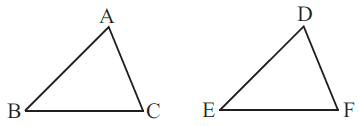
Solution:-
By SSS congruence property: Two triangles are congruent if the three sides of one triangle are respectively equal to the three sides of the other triangle.
ΔABC ≅ ΔDEF
(b) Given: ZX = RP
RQ = ZY
∠PRQ = ∠XZY
So, ΔPQR ≅ ΔXYZ

Solution:-
By SAS congruence property: Two triangles are congruent if the two sides and the included angle of one are respectively equal to the two sides and the included angle of the other.
ΔACB ≅ ΔDEF
(c) Given: ∠MLN = ∠FGH
∠NML = ∠GFH
∠ML = ∠FG
So, ΔLMN ≅ ΔGFH

Solution:-
By ASA congruence property: Two triangles are congruent if the two angles and the included side of one are respectively equal to the two angles and the included side of the other.
ΔLMN ≅ ΔGFH
(d) Given: EB = DB
AE = BC
∠A = ∠C = 90o
So, ΔABE ≅ ΔACD
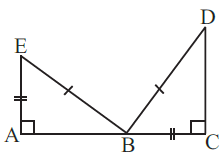
Solution:-
By RHS congruence property: Two right triangles are congruent if the hypotenuse and one side of the first triangle are respectively equal to the hypotenuse and one side of the second.
ΔABE ≅ ΔACD
2. You want to show that ΔART ≅ ΔPEN,
(a) If you have to use the SSS criterion, then you need to show
(i) AR = (ii) RT = (iii) AT =
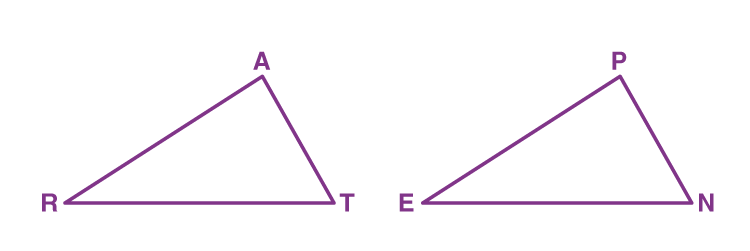
Solution:-
We know that,
SSS criterion states that two triangles are congruent if the three sides of one triangle are respectively equal to the three sides of the other triangle.
∴ (i) AR = PE
(ii) RT = EN
(iii) AT = PN
(b) If it is given that ∠T = ∠N and you are to use the SAS criterion, you need to have
(i) RT = and (ii) PN =

Solution:-
We know that,
SAS criterion states that two triangles are congruent if the two sides and the included angle of one are respectively equal to the two sides and the included angle of the other.
∴ (i) RT = EN
(ii) PN = AT
(c) If it is given that AT = PN and you are to use the ASA criterion, you need to have
(i) ? (ii) ?

Solution:-
We know that,
ASA criterion states that two triangles are congruent if the two angles and the included side of one are respectively equal to the two angles and the included side of the other.
Then,
(i) ∠ATR = ∠PNE
(ii) ∠RAT = ∠EPN
3. You have to show that ΔAMP ≅ ΔAMQ.
In the following proof, supply the missing reasons.
| Steps | Reasons |
| (i) PM = QM | (i) … |
| (ii) ∠PMA = ∠QMA | (ii) … |
| (iii) AM = AM | (iii) … |
| (iv) ΔAMP ≅ ΔAMQ | (iv) … |
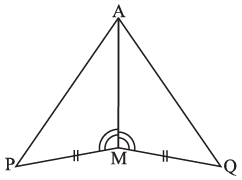
Solution:-
| Steps | Reasons |
| (i) PM = QM | (i) From the given figure |
| (ii) ∠PMA = ∠QMA | (ii) From the given figure |
| (iii) AM = AM | (iii) Common side for both triangles |
| (iv) ΔAMP ≅ ΔAMQ | (iv) By SAS congruence property: Two triangles are congruent if the two sides and the included angle of one are respectively equal to the two sides and the included angle of the other. |
4. In ΔABC, ∠A = 30o , ∠B = 40o and ∠C = 110o
In ΔPQR, ∠P = 30o , ∠Q = 40o and ∠R = 110o
A student says that ΔABC ≅ ΔPQR by AAA congruence criterion. Is he justified? Why or Why not?
Solution:-
No, because the two triangles with equal corresponding angles need not be congruent. In such a correspondence, one of them can be an enlarged copy of the other.
5. In the figure, the two triangles are congruent. The corresponding parts are marked. Can we write ΔRAT ≅ ?

Solution:-
From the given figure,
We may observe that,
∠TRA = ∠OWN
∠TAR = ∠NOW
∠ATR = ∠ONW
Hence, ΔRAT ≅ ΔWON
6. Complete the congruence statement:
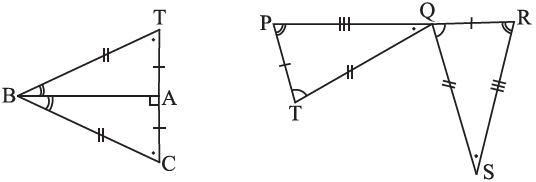
ΔBCA ≅ ΔQRS ≅
Solution:-
First, consider the ΔBCA and ΔBTA
From the figure, it is given that,
BT = BC
Then,
BA is the common side for the ΔBCA and ΔBTA
Hence, ΔBCA ≅ ΔBTA
Similarly,
Consider the ΔQRS and ΔTPQ
From the figure, it is given that
PT = QR
TQ = QS
PQ = RS
Hence, ΔQRS ≅ ΔTPQ
7. In a squared sheet, draw two triangles of equal areas such that
(i) The triangles are congruent
(ii) The triangles are not congruent
What can you say about their perimeters?
Solution:-
(i)
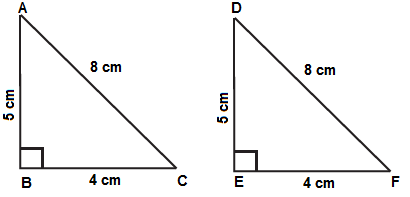
In the above figure, ΔABC and ΔDEF have equal areas.
And also, ΔABC ≅ ΔDEF
So, we can say that the perimeters of ΔABC and ΔDEF are equal.
(ii)

In the above figure, ΔLMN and ΔOPQ
ΔLMN is not congruent to ΔOPQ
So, we can also say that their perimeters are not the same.
8. Draw a rough sketch of two triangles such that they have five pairs of congruent parts, but still, the triangles are not congruent.
Solution:-
Let us draw triangles LMN and FGH.

In the above figure, all angles of two triangles are equal. But, out of the three sides, only two sides are equal.
Hence, ΔLMN is not congruent to ΔFGH.
9. If ΔABC and ΔPQR are to be congruent, name one additional pair of corresponding parts. What criterion did you use?
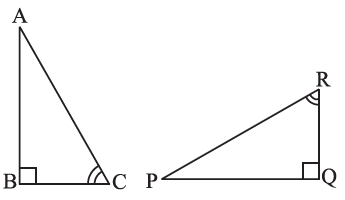
Solution:-
By observing the given figure, we can say that
∠ABC = ∠PQR
∠BCA = ∠PRQ
The other additional pair of corresponding parts is BC = QR
∴ ΔABC ≅ ΔPQR
10. Explain, why ΔABC ≅ ΔFED
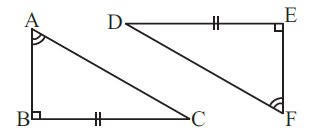
Solution:-
From the figure, it is given that,
∠ABC = ∠DEF = 90o
∠BAC = ∠DFE
BC = DE
By ASA congruence property, two triangles are congruent if the two angles and the included side of one are respectively equal to the two angles and the included side of the other.
ΔABC ≅ ΔFED